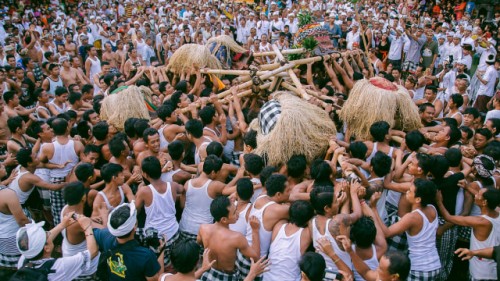
Dewa Mesraman or Masraman is a tradition that must be held in Banjar Timbrah, Adat Paksebali Village, Dawan District, Klungkung Regency, this unique tradition is held every 6 months and it’s a series of Pujawali Pura Timbrah (Timrah) Temple. The Dewa Mesraman tradition is an ancestral legacy that began in 1500 and still continues to be held routinely by the locals. As a series of pawawali ceremonies at Pura Timrah which falls on Saniscara Kliwon wuku Kuningan, this tradition coincides with the convening of the Kuningan holiday.
The Tradition of the Dewa Mesraman in Klungkung also has a historical story about the origin of the tradition. Perhaps in the past time, the tradition of the Dewa Mesraman as already in Karangasem. At that time Klungkung and Karangasem had inter-regency borders to protect the border. Panti Timrah Village, a village in the Karangasem area, sent several residents to help guard the border, which is now under the auspices of the Klungkung Regency.

Source:@putubudimaryadi08
The residents who promoted to be border guard wanted to preserve the traditions and culture that they already had at the Panti Timrah Village. One of them is the Dewa Mesraman tradition which is the legacy of their ancestors that they want to hold without relieving or adding rules that are inherent in the tradition. For this reason, residents who were sent to maintain the border region held the Dewa Mesraman Tradition even though they were not already in their native area, and now the border region enters the Klungkung regency and the tradition automatically become the part of the Regency.
At 8 am, the local community will gather all the facilities and infrastructure needed to establish the ceremony. When all offerings are ready, the community will gather at Pura Timrah to make lawar. Lawar is a Balinese food, this ceremony required as many as 5 types of lawar that will be made which consists of: starfruit lawar, jackfruit lawar, bean lawar and gedang lawar (papaya). Making this lawar has a symbol as a unifying form of all the differences that exist in the village.
At around 3 pm, the making of the lawar was finished, then proceed with the nunas paica (blessing) which contained lawar, rice, and satay with a base covered in banana leaves. Nunas paica involves children who have not yet reached adulthood. The meaning of nunas paica is a form of giving provision to children so that later they will have basic teachings in growing up and can help them in character building.
After the nunas paica activity, it was continued with megibung (eating together) with a menu of white rice, lawar, salt and based on klakat. This activity involves adults. The meaning of the megibung procession is to unite all the different characteristics and behaviors of Paksebali Village residents.
At 5:00 pm a purification ceremony was held by the villagers from a traditional village where 1 puppet was raised 2 eels and was taken to the river of water (water source). This process is meant to solicit holy water and purify the body of the worshipers before and after the ceremony of the Mesraman God. Once it is cleaned then the jempana is brought back to the temple.
Upon arriving in the middle of the 7 pm, the dance will be attended by a rejang dance attended by native Paksebali Village girls who have not yet reached adulthood. After that, it will also be welcomed with a baris dance that holds a keris in her right hand and 6 of the 7 jempana that are carried begin to be paraded as if a war is happening. Besides that, baris dancers surround jempana by chasing and crashing each jempana from one to another. the shape of the jempana is wrapped around like a war, the war of Jempana in Paksebali is called the Dewa Mesraman.
Thumbnail Source: Wayan Mardana